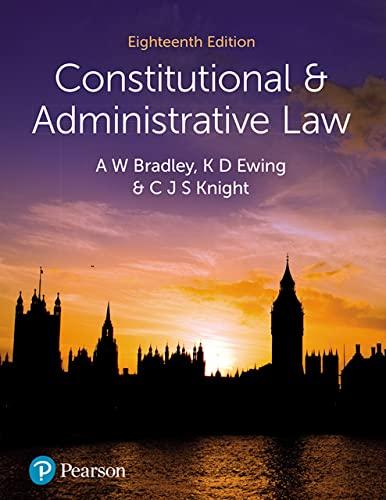Question
Lori lives near a cement factory. Each morning, her car is covered with a fine dust emitted from the factory. The factory knows about this
Lori lives near a cement factory. Each morning, her car is covered with a fine dust emitted from the factory. The factory knows about this problem, as Lori and the neighbors have complained repeatedly about it. Scientists have determined that the dust is not dangerous, but it is a constant annoyance. It would be very expensive to eliminate. The cement factory is a major employer in the area, and its value is estimated at around $45 million. The local economy is also heavily dependent on taxes from the factory. Experts have estimated that the loss of property value to Lori and other nearby homeowners from the dust is about $185,000. Lori and these other homeowners sue for private nuisance, arguing that the factory's conduct is a nuisance under Restatement (Second) of Torts section 822(a). They want damages for their decline in property value. The factory concedes that Lori and the other homeowners can prove intent but argues that its behavior is not unreasonable. How should the court respond to this argument?
A
The court should reject the argument, so long as the court believes the harm to the plaintiffs is serious and the factory can compensate Lori and the other homeowners without facing an insurmountable financial burden.
B
The court should accept the argument because to allow nuisance claims like Lori's to go forward means shutting down big factories.
C
The court should accept the argument because the gain to the cement factory exceeds the loss to Lori and the other homeowners.
D
The court should reject the argument because the costs of eliminating the dust are exceeded by the benefits of allowing pollution to go forward.
Lori lives near a cement factory. Each morning, her car is covered with a fine dust emitted from the factory. The factory knows about this problem, as Lori has complained repeatedly about it. Scientists have determined that the dust is not dangerous, but it is a constant annoyance. Because of the wind patterns, only Lori has the dust problem. The cement factory is a major employer in the area, and its value is estimated at around $45 million. The local economy is also heavily dependent on taxes from the factory. Experts have estimated that the loss of property value to Lori is about $1000. Lori has sued for private nuisance, arguing that the factory's conduct is a nuisance under Restatement (Second) of Torts section 822(a). She wants damages for the decline in her home's property value. She argues the factory's behavior is unreasonable under section 829A, and therefore she need not prove unreasonableness in the ways set forth in section 826. How should the court respond to this argument?
A
The court should accept the argument because Lori's harm is serious.
B
The court should reject the argument because the costs of eliminating the dust are exceeded by the benefits of allowing pollution to go forward.
C
The court should reject the argument, so long as the court believes the harm to the plaintiffs is serious and the factory can compensate Lori and the other homeowners without facing an insurmountable financial burden.
D
The court should reject the argument because Lori's harm is not severe.
Step by Step Solution
There are 3 Steps involved in it
Step: 1

Get Instant Access to Expert-Tailored Solutions
See step-by-step solutions with expert insights and AI powered tools for academic success
Step: 2

Step: 3

Ace Your Homework with AI
Get the answers you need in no time with our AI-driven, step-by-step assistance
Get Started


